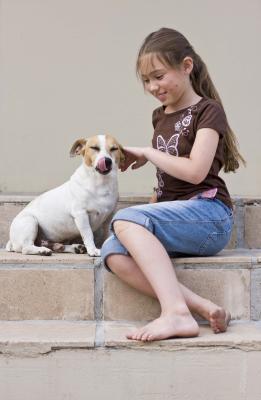You just met another mom who has a little girl the same age as yours who happens to live in your neighborhood. She invites you and your daughter over. You are both excited about the prospect of making new friends. That is, until you both see that they have a dog. Your daughter is now hiding behind your legs, and not having a dog yourself, you are not quite sure what to do.
Fear in Child
If your child has been bitten or attacked by a dog in the past, it’s pretty easy to figure out why he might be afraid of dogs. But if your child has not had any negative experiences with dogs and is afraid of them anyway, it’s probably because of a fear of the unknown and the unexpected, Linda P. Case of the University of Illinois College of Veterinary Medicine told WebMD. This type of fear is typical in some children who are never around dogs. Another reason your child may be afraid could be that you told him to be careful around strange dogs — sound advice but scary nevertheless.
Fear in Dog
The behavior of little kids can also be scary to a dog. Little kids tend to stare at a dog at eye level, scream and yell, run erratically and flail their arms, certified pet trainer Renee Payne described to WebMD. This behavior makes the dog’s behavior less than friendly. The trick is to get your child and the dog to have a meeting of the minds.
Pack Animals
Dogs are pack animals that establish hierarchy. They sometimes knock kids down or give them a bite to dominate. Teach your child the warning signs a dog exhibits, such as growling or baring teeth. Your child should stop what she is doing at that moment. Otherwise, the dog is likely to bite. If this is your dog, you need to put the dog in its place by making it submit to you. This lets the dog know that it can’t dominate your child. If this is someone else’s dog, remove your child from the situation.
Helping Your Child
Accept that your child is afraid of dogs. Then make sure you are not making the problem worse by warning about the dog biting, for example. Desensitize your child by looking at pictures of dogs, by going to a pet store and looking at dogs and by going to a park where dogs are playing. Don’t force your child to do anything; rather, let him go at his own pace. The first dog your child should meet is a relaxed, mellow, older dog. In a matter-of-fact way, let your child touch the dog’s body. Stay away from the head at the start because that is more intimidating to a child, says Payne. Tell your child that the dog wants to sniff him and maybe even give him a kiss (a lick). Teach your child to respect the dog and never to pull its tail or hit it. Of course, you still need to reinforce the importance of never approaching a strange dog without first asking whether it’s OK.
Trying Out a Dog
Take your child to a dog rescue center. The two of you may be able to volunteer to take a dog for a short walk or simply sit with, pet and brush a dog. Explain to the volunteers that you need a mellow dog for your child. Your child may get to the point where she feels comfortable enough to foster the dog for a weekend. You may wind up with a permanent furry friend, though, if you take that approach.





